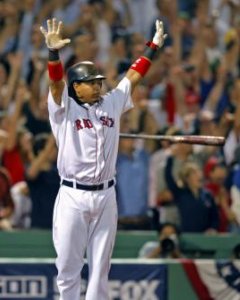Red Sox fans this morning were ecstatic, albeit still a little sleepy, after staying up late to catch the end of Boston’s sixth straight victory won in dramatic fashion, thanks to back-to-back, late-inning home runs from sluggers Manny Ramirez and David Ortiz, over the nose-diving Chicago White Sox. It was the first time since late April that the Red Sox had swept a road series and earned Boston some revenge after losing two-of-three last weekend at Fenway to these same White Sox. It also meant that, after being 10-1/2 games behind New York at the start of last week, they had climbed back to with 5-1/2 games thanks to New York, who had lost five-of-six last week and were swept over the weekend at home by the red-hot Anaheim Angels.
Just last week, a lock for the American League East title in 2004 seemed like a foregone conclusion for the Yankees and, for the seventh straight season, the only chance for the Red Sox to see the post-season would be to focus on two or three other teams that were competing for the coveted wild card playoff spot. Suddenly, with the Yankees sputtering and the Red Sox flying high, even the most pessimistic Boston fan is paying attention once again to the division race.
It’s still going to take quite an effort for Boston to catch New York in the standings. If the Yankees play just over .500 ball for the rest of the season (20-19), the Red Sox would need to win 27 of the remaining 40 games left on the schedule. Put another way, with 12 series that remain to be played, the Sox could not afford to lose more than one game in each series. Two of those series will be played against the Yankees: one three-game weekend series at “The House That Ruth Built” followed by another three-game series at “Friendly” Fenway.
Boston also has a more difficult schedule left to play. 13 games remain against West Division opponents and three of those teams are in the playoff hunt: the Angels, the Oakland Athletics, and the Texas Rangers. The Red Sox play two of those series at home against Anaheim and Texas, then fly straight to Oakland to play three more games before wrapping up the road trip with four in Seattle. Meanwhile, other than Boston, New York will face just one other team that has a record better than .500: the Minnesota Twins. The rest of these games include three series with Toronto, two each with Cleveland and Baltimore, and one each with Tampa Bay and Kansas City; New York is a combined 31-8 against all these teams, not including the slumping Indians with whom they have yet to play.
The wild card edge, without a doubt, goes to Boston, and I don’t say that just because of my loyalty to the Boston nine. Head-to-head against the other three contenders, Boston is even in strength and should stand toe-to-toe with them; with two of these series coming at home, the Red Sox should have a slight advantage. Also, Anaheim, Oakland, and Texas must all play each other several more times before the season ends while Boston has several division series against weaker opponents that should be easy to take. Thus, the three West Division rivals should tear each other apart while Boston enjoys the view from the sidelines and moves further ahead in the wild card lead.
So, with the wild card so easily within reach, are the Red Sox only hurting themselves if they attempt to catch New York? To quote a well-known former Yankee great: “It ain’t over until it’s over.” History proves that New York is resilient and that they will fight right down to the final out. Plus, given an easier schedule over the next few weeks, perhaps some young pitching staffs will help New York regain it offensive edge while the club’s own pitching staff tries to regroup. However, nothing is set in stone and, if the Sox can stay hot, those two series between the two clubs could prove interesting. To say that I would love to see a reversal of fortune come in favor of Boston would be wonderful but, to put it in another perspective, a division crown is not the most impressive piece of hardware that can be placed in the trophy cabinet at the end of the season.
